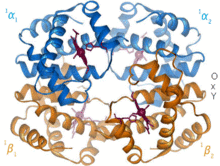Biological pigment
In biology, pigment (Latin pigmentum 'colour, dye') refers to all colouring substances and structures in the cells of unicellular and multicellular organisms.
Pigments can be indispensable in a cell, for example the bacteriochlorophylls for anoxygenic photosynthesis or the chlorophylls for oxygenic photosynthesis. Furthermore, they may be necessary for cellular respiration (like cytochromes). Furthermore, they can be needed in multicellular organisms for oxygen storage (myoglobins), oxygen transport (haemoglobins), light perception (photopigments) or light protection (melanins).
Furthermore, pigments are used for inconspicuous surfaces (camouflage) or for conspicuous signals. In this way, they can be found in many plants and animals in the formation of surfaces, for example in cuticle and fruit shell, leaf and flower, mussel shell or chitinous shell, snail shell, butterfly wing, bird feather, scale, hair or skin.
The coloured effect may be caused by the selective absorption of light in the colour-bearing portion of soluble dyes or insoluble pigments called chromophore. It can also be caused by reflection, scattering and refraction on (often multilayer) structures, possibly with iridescent effects due to interference.
Biological pigments are mostly embedded in membranes and cells. A pigment-bearing membrane envelope within cells is called a chromatophore, also a membrane-enveloped plastid; the granular stacks of lamellae inside chloroplasts are called grana. A pigment cell is also called a chromatophore; one (melanophore) in primate skin is the melanocyte, in whose membrane-enclosed organelles (melonosome) the pigment melanin is formed. Its transfer to horn-forming cells decisively determines the natural colour of skin and hair, also in humans.

In the blood pigment haemoglobin, the structure of this iron-protein complex changes when oxygen molecules are taken up (oxygenation) and thus its colour changes from dark to light red, and vice versa when oxygen is released (deoxygenation).
Pigments in plants
The most important pigments contained in plants and algae, which are also responsible for the green coloration in embryophytes and green algae, are chlorophylls. All plants (kingdom Archaeplastida = Plantae) and algae contain chlorophyll a. Besides morphological differences, the Archaeplastida are divided into three subgroups according to the type of additional pigments contained, depending on whether chlorophyll b, xanthophylls and/or phycobilins are additionally contained.
Algae with complex plastids originating from an endosymbiosis with a red alga contain chlorophyll b instead of chlorophyll c in most cases.
The phycobilisomes, the light-collecting complexes of cyanobacteria, red algae, glaucocystophyceae and the thecate amoeba Paulinella chromatophora, consist of biliproteins. While phycocyanin and allophycocyanin are present in all phycobilisomes, phycoerythrin is formed only in red algae and cyanobacteria - but not in all. Cryptophyceae contain only one strongly modified phycoerythrin as a light-collecting complex instead of phycobilisomes.
The anthocyanins and flavones dissolved in the cell sap are also counted among the pigments, as are the phlobaphenes which are stored in the walls of dead cells.
Pigments in humans and animals
In animals, melanins, carotenoids, guanine and bile pigments are the most important pigments. The pigments are found, among other things, in skin, hair, scales, feathers or chitinous shells. Animal pigments can be concentrated in pigment cells (chromatophores) or dissolved in body fluids.
Butterflies produce additional colour effects by interference on the scales. Skeletons and shells made of calcium carbonate (lime), such as those found in sponges, mussels or snails, can contain inorganic pigments.
The skin colour of mammals is predominantly due to melanins. Haemoglobin, the colouring substance of the blood of vertebrates, changes the colour of the iron-haemoglobin complex from red to reddish violet through the uptake and release of molecular oxygen. The cause is a structural change with a constant oxidation number of +II of the iron atom in the heme.
In case of reduced pigmentation one speaks of hypopigmentation, in case of increased pigmentation of hyperpigmentation.
Search within the encyclopedia